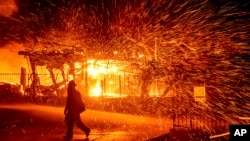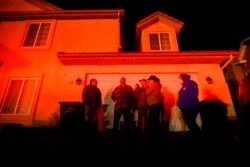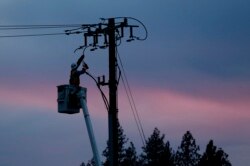The power company that serves more than 5 million people in one of the world’s most technologically developed areas has to make a decision: turn off the electricity or risk starting wildfires.
Pacific Gas & Electric, PG&E, is $30 billion in debt and needs billions more to modernize its aging power system. Many Californians are unsure as to whether the company can safely provide electricity to a large part of the state.
The company’s troubles come from years of poor leadership and even worse government oversight. Combine those problems with both climate change and a housing shortage, and a crisis appears.
“There’s a ton of blame to go around here,” said Christopher Knittel. He directs the Center for Energy and Environmental Policy at the Massachusetts Institute of Technology’s Sloan School of Management.
The problem and its possible answers are the top concern for California politicians. Most experts agree that the fires and the power outages will continue for years and all energy will cost more.
“It’s not just going to be a PG&E cost,” notes Matthew Cordaro, a longtime power company official with the Long Island Power Authority. “The consumer’s going to have to pay for it,” he said.
Starting wildfires
In California, a lot of people live near power lines in forests that are very dry. Two years ago, electrical sparks from power lines started several fires that destroyed large parts of Northern California and killed more than 20 people. A year later, PG&E power lines started the Camp Fire, which destroyed the town of Paradise, killing 85 people.
The power company is responsible for about 200,000 kilometers of power lines. Many of the lines go through forests that are dry after years of low rainfall. The forests are also filled with dead trees, more than 138 million in all, experts believe. They are possible fuel for wildfires.
Another issue is housing. A lack of housing in cities has pushed land development into the forests, where there are few barriers to building.
In addition, California’s climate is warming. Scientists cannot blame climate change alone for any of the fires, but they say it is partly responsible for higher temperatures and stronger winds. That causes the fires to spread faster and farther.
Five of the state’s 10 largest fires and seven of the 10 most destructive have happened over the past 10 years. The deadliest fires were started by power lines.
More than half of PG&E’s 181,000 square kilometers of service area is known to be at high risk for fires. That information comes from a plan the company gave to state officials this year. That plan explained how the company was going to try to avoid causing more fires.
But PG&E has had a lot of problems.
Repairing the aging power system
The company has failed to perform all the necessary repairs to its systems. It was found criminally responsible for a deadly explosion in its gas system in the community of San Bruno in 2010.
California Governor Gavin Newsom has accused PG&E of caring more about profits than safety. It failed to cut back trees growing near wires. The company has admitted it still has several thousand kilometers of dangerous, old-fashioned wire in high-risk areas. That wire can break and arc, setting off fires.
PG&E’s chief executive officer Bill Johnson has said it will take 10 years to get the system modernized and working. For now, Californians will have power outages – days or weeks without electricity -- to prevent fires.
Company officials say they have invested $27 billion in their power system over the past 10 years.
Power companies are some of the most regulated businesses in the United States. PG&E’s regulator failed to see fire risk and, as a result, failed to force the company to prepare for it.
Nearly 20 years ago, PG&E first declared bankruptcy after California’s energy crisis. Regulators and politicians had the chance to force the company to change the way it operated. Instead, they mostly ignored the problem, letting the company make its own plan to return to profitability by charging much higher prices.
Now it is in bankruptcy again.
I’m Susan Shand.
The Associated Press reported this story. Susan Shand adapted it for VOA Learning English. George Grow was the editor.
Write to us in the Comments Section or on our Facebook page.
________________________________________________________________
Words in This Story
arc – n. a very long electrical spark
regulate – v. to control or supervise something by using rules
bankruptcy – n. a condition of financial failure caused by not having the money that you need to pay your debts
consumer – n. a person who buys goods and services












